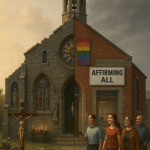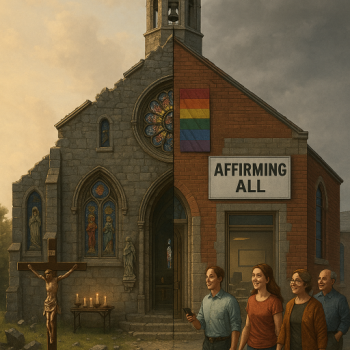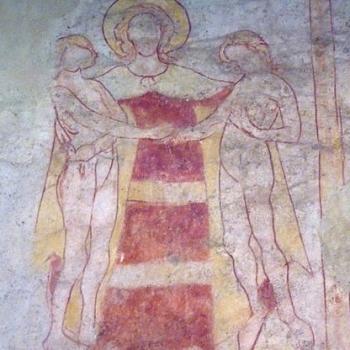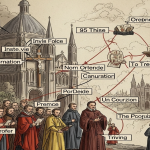 Guest writer: Pilgrim
Guest writer: Pilgrim
Introduction
This post examines how the essential marks of holiness and catholicity, often seen as opposites, are complementary. The next article will explore a deeper challenge: how modernist and progressive ideas have introduced confusion and doctrinal drift. While this post acknowledges the danger of extremes, its focus remains on how the Church must hold together holiness and catholicity as mutually enriching dimensions of her identity and mission.
Can the Church Be Both Smaller and Greater?
“The Church will become small,” Joseph Ratzinger once predicted, “but she will find her centre anew.”
In a time of scandal, secularism, and spiritual fatigue, Catholics are asking hard questions about the future of the Church. Should we aim to be leaner and holier, even if that means being less culturally relevant? Or should we press harder on the Church’s mission to reach everyone, embracing diversity and dialogue? Some fear we’re splintering. Others see a refining.
Beneath the tensions lies something deeper: a longing for the Church to be truly herself: one, holy, catholic, and apostolic; faithful and expansive; rooted and reaching.
What if we need both a purified core and a renewed missionary heart?
A Crisis That Demands Witness
The abuse crisis was not just a scandal. It was a betrayal of Christ’s own Body. St. Gregory the Great warned that when shepherds lack virtue, the flock scatters. We’ve witnessed this firsthand.
Yet the response cannot be institutional defensiveness. It must be deeper conversion. This is not merely a time for policies. It is a time for saints.
A Church That Prioritises Sanctity Over Status
Many Catholics, especially in the wake of the abuse crisis, sensed that the Church had become too worldly. Too preoccupied with numbers, image, and institutional power. The crisis, in this light, wasn’t just a moral failure; it was a spiritual unmasking.
Thinkers like Joseph Ratzinger and Henri de Lubac saw this coming. They urged a return to the Church’s soul: a place where truth is proclaimed without compromise and where holiness, not popularity, is the measure of success. The Church, they argued, cannot be a mirror of society’s whims. She must be a window to the divine.
This vision isn’t nostalgic: it’s radical. It calls us to let go of prestige and power, and to embrace the humbling path of discipleship.
At the heart of this purification is the Eucharist, the source and summit of the Church’s life. In the sacrament of Christ’s Body and Blood, the Church rediscovers her centre. Not in strategy, numbers, or influence, but in the self-giving love of the Crucified. Here the Church becomes truly herself: gathered, sanctified, and sent. It is around the altar that the holiness of the Church is most visible and most vulnerable, calling each of us not to management but to adoration, not to dominance but to communion, which then propels us outward in mission to share this divine life.
A Church That Holds Fast to Truth
This “smaller, purified” vision is committed to doctrinal clarity. It resists the temptation to dilute Church teaching to seem modern, diverse, or inclusive. Whether on anthropology, moral theology, the priesthood, or the liturgy, fidelity serves as the only foundation for credibility.
This isn’t rigidity for its own sake. It’s a belief that only the truth sets us free. That pastoral care without doctrine becomes sentimentality, and doctrine without charity becomes harshness. The Church, in this view, must walk the narrow path: loving boldly, but truthfully.
A Church That Seeks Depth Over Size
Remember Jesus’ words: “Fear not, little flock.” This vision accepts that faithfulness may cost us numbers. Ratzinger spoke of a Church reduced in size but not in vitality. A Church renewed from within, not propped up by cultural convenience. A Church that people would rediscover.
Yves Congar echoed this, teaching that reform comes through humility, not relevance. True growth is measured not by metrics, but by the depth of conversion and love.
A Church That Resists Relativism
Some Catholics worry that, since Vatican II, a spirit of relativism has crept in. A confusing mix of pastoral openness with doctrinal vagueness. Leaders like Cardinal Robert Sarah and Pope Benedict XVI have warned against this. They see worship, catechesis, and formation as areas where clarity must return.
This isn’t a call to close off dialogue, but to anchor it. We cannot bring Christ to the world if we lose sight of who He is.
A Church That Reaches Out in Love
Holiness alone is not enough.
The Catholic Church exists to evangelize. Vatican II’s Gaudium et Spes called the Church to read the “signs of the times” and to walk alongside humanity in all its suffering, searching, and striving.
Pope Francis, in Evangelii Gaudium, paints a picture of a Church that is not withdrawn but engaged; a Church that listens, heals, and accompanies. His image of the Church as a “field hospital” is pastoral theology in action. We don’t wait for the wounded to become well before offering grace. We meet them where they are.
A Church That Welcomes Every Culture
This missionary vision embraces inculturation: adapting the form of the Gospel to every people and place. Just as the Word became flesh in a particular time and culture, so too must the Church find ways to make Christ visible today—in new languages, symbols, and gestures.
It’s not about changing doctrine, but about expressing the same truth in ways people can recognise and receive.
A Church That Walks Together
The Synod on Synodality emphasizes that all the baptized have a voice. The sensus fidelium – the “sense of the faithful” – isn’t just democratic sentiment. It’s the Spirit moving through the Body of Christ, a supernatural appreciation of the faith that is authentic when it adheres to the Deposit of Faith and is guided by the Magisterium. Bishops, clergy, religious, and laity are all called to discern together.
This doesn’t mean relativism. It means reverent listening. It means trusting that the Holy Spirit did not leave the Church after the Acts of the Apostles.
A Church That Is Both Holy and Catholic
The Church today faces a real tension, but not an impossible division. What some describe as competing visions—one focused on holiness and doctrinal integrity, the other on catholicity and pastoral inclusion—can be more fruitfully understood as distinct but complementary emphases. Each highlighting something essential about the Church’s nature and mission.
There are dangers at both extremes: an insular traditionalism that resists the Spirit’s movement, and a progressive-modernism that dilutes doctrine in the name of relevance. But these do not define the faithful majority. Most Catholics today seek renewal, integrity, and holiness, while also yearning for mercy, outreach, and communion. The question is not whether the Church should either be smaller or broader, but whether she will become more deeply herself: both holy and catholic.
Decades ago, Ratzinger foresaw a Church smaller in numbers but purified and strengthened in faith. Hans Urs von Balthasar insisted that “truth is symphonic,” requiring a unity that includes legitimate diversity. Romano Guardini saw crisis as a purifying fire that strips away false securities, revealing the essence of divine truth.
This emphasis on holiness, however, must always be understood in light of the Church’s universal mission. Vatican II reminded us that the Church is “the universal sacrament of salvation.” Pope Francis calls us to be a Church of accompaniment and mercy, not just purity and clarity. Fidelity to the Gospel is preserved not by shrinking inward, but by growing deeper in love and more courageous in mission.
The Magisterium, the teaching office of the bishops in communion with the Pope, plays a vital role in holding this tension together. It safeguards the deposit of faith, interprets doctrine faithfully, and helps the Church discern between authentic development and distortion. In this way, the Church’s apostolicity binds holiness and catholicity together: grounding her sanctity in the truth handed down from the Apostles, and ensuring that her universal mission remains faithful to the Gospel in every age.
As Guardini wrote, the Church awakens in souls during every age. Her holiness is not a defensive purity, and her universality is not a shallow inclusivity. She is holy because Christ is holy; she is catholic because His love is for all. In crisis, as in renewal, she is most herself when she embraces both dimensions of her identity and walks the narrow way of truth and mercy.
In that tension, we find hope. Not a naïve optimism, but a hope born of faith that the Holy Spirit continues to guide the Church. It is a hope that requires discernment, courage, and trust. And it involves risk: the risk of being misunderstood, the risk of stepping into uncomfortable spaces, the risk of loving with both truth and mercy. But that is the path of the Cross. It is also the path to resurrection.
Conclusion
If we hold together this tension of holiness and mission successfully, we will be prepared to confront deeper forces pulling the Church off course. In the next article, I hope to examine how progressive-modernist currents have attempted to reshape contemporary Catholic discourse, often blurring essential truths. Understanding these distortions is a necessary step toward clarity, reform, and renewal.
Bibliography
Magisterial Documents & Catechism
• Catechism of the Catholic Church, esp. §§748–780 (the Church), §§1428–1439 (conversion and mercy), §§849–856 (missionary mandate), §§2032–2040 (magisterium and moral teaching)
• Gaudium et Spes, Vatican II (Pastoral Constitution on the Church in the Modern World)
• Lumen Gentium, Vatican II (Dogmatic Constitution on the Church)
• Evangelii Gaudium (Pope Francis, Apostolic Exhortation, 2013)
• For a Synodal Church: Communion, Participation, and Mission (Synod Preparatory Document, 2021)
• Ubicumque et Semper (Pope Benedict XVI, Apostolic Letter on the New Evangelization, 2010)
Key Theologians and Thinkers
• Joseph Ratzinger (Pope Benedict XVI), Faith and the Future, Introduction to Christianity
• Henri de Lubac, The Splendor of the Church
• Yves Congar, True and False Reform in the Church
• Hans Urs von Balthasar, Truth is Symphonic: Aspects of Christian Pluralism
• Cardinal Robert Sarah, The Day Is Now Far Spent
• Romano Guardini, The End of the Modern World, The Church and the Catholic
• St. Gregory the Great, Pastoral Rule
Thank you!
If you liked this article, please leave your comments below. I am very interested in your opinion on this topic.
Read The Latin Right’s other writing here.
Please visit my Facebook page and IM your questions (and follow my page) or topics for articles you would like covered.











